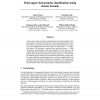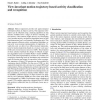46 search results - page 4 / 10 » Spatial Representation for Efficient Sequence Classification |
BIOINFORMATICS
2005
13 years 7 months ago
2005
A key issue in supervised protein classification is the representation of input sequences of amino acids. Recent work using string kernels for protein data has achieved state-of-t...
CVPR
2010
IEEE
14 years 1 months ago
2010
IEEE
We introduce a novel framework for nonrigid feature
matching among multiple sets in a way that takes into consideration
both the feature descriptor and the features spatial
arra...
ICIP
2007
IEEE
14 years 9 months ago
2007
IEEE
In this work we present a method to jointly separate active audio and visual structures on a given mixture. Blind Audiovisual Source Separation is achieved exploiting the coherenc...
BMCBI
2004
13 years 7 months ago
2004
Background: Hidden Markov Models (HMMs) have proven very useful in computational biology for such applications as sequence pattern matching, gene-finding, and structure prediction...
MMS
2006
13 years 7 months ago
2006
Motion trajectories provide rich spatio-temporal information about an object's activity. The trajectory information can be obtained using a tracking algorithm on data streams ...



